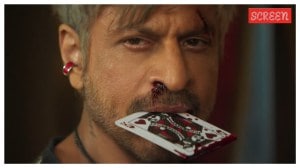Lives gone sour: Saline water is bane of over 300 villages
KHARTALE (MAHARASHTRA) April 11: They dig wells to discover salt. They demand the cost of migration for their young sons in dowry. They drin...

KHARTALE (MAHARASHTRA) April 11: They dig wells to discover salt. They demand the cost of migration for their young sons in dowry. They drink saline water, suffer from related diseases and have forgotten to complain.This is the story of people living on the saline track of Purna river basin in Vidarbha region where every drop of ground water is as saline as sea.
About 348 villages spread in three districts — Amravati, Akola and Buldhana — have learnt to digest saline water, chronic diarrhoea and other diseases notwithstanding.
The Purna basin stretches from the Satpura ranges in the North to the Ajantha ranges in the South. The major portion of the basin comprises deep alluvium. Of the 7500 sq km of catchment area of the river, 3,000 sq km has saline ground water. The chloride content of here varies between 500 mg/l to 2000 mg/l and salinity increases with depth. Geologist P G Adyalkar says that Purna valley was part of the Arabian sea connected through Tapi valley centuries ago. In the course of timesilting in the valley severed its connection with the sea. The fact that the salinity is centuries old natural phenomena makes the people more helpless and the administration more complacent.
Khartale village, one of the worst affected, greets the visitors with a community tap that pours out salty water. A group of women dare visitors to swallow a mouthful of the water. They burst into laughter when the enterprising visitor throws up water with a violent shriek.
But behind that light hearted laughter is the suffering of generations. “We have grown up with the worst of health…My four-year-old grandson can eat more than I…he lives in Nagpur,” says Sridhar Gulani who is in his sixties but appears to be in the eighties.
For young men here, marriage and migration go hand in hand. “Girls from better families would never marry boys living in these villages. While fixing the amount of dowry most parents keep provision for meeting the expense of migrating their sons to the land of sweet waters.”
Thestories of young girls in these villages are more tragic. “I had gone to see some girls in the villages before my marriage,” says a civil engineer with the state irrigation department. “But the girls were bone-thin…everybody grows thin here with a pound of flesh around their belly,” he observes.
Not surprisingly, water is the main cause for village-level quarrels. Valge police station has more than 80 per cent cases of water-related violence. “People here fight only for water,” a constable at Khartale says.
And thus the salinity ingresses in lives of people here is complete despite the millions of rupees the state has pumped in over the last few decades. But most of the efforts turned out to be temporary with the salinity always overtaking efforts.
In Adura-Bazaar village, people have dug wells all over with the government money. In the village of not more than 500 families, there are two borewells and two open wells of which one is right in the river bed. But each one of them throws out salinewater.
Bajarang More one of the most vocal residents of the village says that fetching water through pipeline is the only solution. “We have very fertile land but it’s useless without water…We have a full meal ready but we cannot eat it because it’s too salty,” he sums up.
Development of surface water sources and pumping out the salinity are the two main tasks pending before the administration but the latter task turned out to be easier planned than executed, V N Pathak, a civil engineer employed with the state irrigation department says. The government had dug a few lakes but monsoon silt converted the lakes into marshy land. “It is too expensive to repair them,” says Sashikant Kulkarni who has spent years dealing with this problem as a government employee.
The Koli community of these villages used to extract salt from the ground water. But now, as if to rub salt into their wounds, there is no demand for mineral salt and most of them are out of the business.
- 01
- 02
- 03
- 04
- 05





























